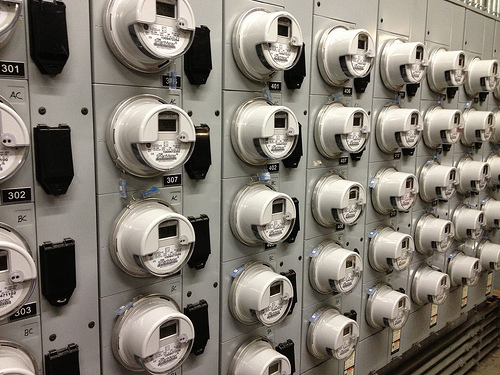
Whether you work alone or have an office full of employees, monthly utility bills can comprise a significant portion of your company's expenditures. But just because your initial budget may have accounted for several hundred dollars a month (or far more) of electricity usage doesn't mean that you're obliged to keep up that quota. By chipping away at your monthly bill through simple measures, you will free up more money for all of your business's other needs. With a thoughtful plan in place, it's possible to cut back on your electricity usage by 40 percent or more, even with more frequent summer heat waves pushing up the demand for power. Here's how to do it:
Upgrade
Get a WiFi-enabled remotely programmable thermostat
Over 50 percent of most buildings' energy use can be attributed to heating and cooling, making it the logical place to begin. We waste a lot of power simply because we don't properly program our thermostats. There is no reason to heat or cool your office to the same level at night as you do during the day, but relying on 'the last employee out the door' to adjust the temperature can be inconsistent. Thermostats that can be adjusted via smartphone like the Nest, Ecobee Smart Thermostat and Lennox iComfort are quickly becoming the new norm. When you have control of your equipment from anywhere, it's far easier to prevent wastefulness.
Kill the vampire
Turn off all the lights in your office and look around at the various work stations. Chances are, there's a glowing array of lights from all the hard drives, computers and chargers left plugged in 24/7. The easiest solution to end this wasteful practice is  through a smart power strip (one option is the Belkin Conserve Smart AV). One device controls the strip, so that when you shut down this primary unit, everything else goes off as well.
through a smart power strip (one option is the Belkin Conserve Smart AV). One device controls the strip, so that when you shut down this primary unit, everything else goes off as well.
Let your light switch work for you
By now, most people realize the savings from switching incandescent bulbs over to compact fluorescents (CFLs). But because CFLs take time to 'heat up,' they're often not the best choice for bathrooms or other 'quick use' areas. Still, two incandescent bulbs can use the same electricity in an hour as a computer monitor, so making the switch is smart, where you can. But the most savings come from simply turning lights off when you're not using them.
Motion-detecting light switches can now be found in the $20 range (and they're as simple to install as a regular switch). They're a smart investment. If nobody is in a room, the light should be off, and a motion sensor switch is the best way to guarantee this.
Maintain
Get your HVAC system checked
Leaks in your ductwork can reduce your cooling and heating system's efficiency by 20 percent. Although a professional inspection may cost $100 or more; discovering and repairing faulty ductwork can quickly save you the upfront expenditure.
Replace air filters
Clogged filters make your system work harder to push air, requiring more electricity and costing you money.
Seal it up
It's possible to check for leaks around doors and windows with a smoking match or incense (look for the smoke to be drawn outside), but a professional can most effectively point out the gaps in your building that are wasting your heated and cooled air. Sometimes these holes are obvious -- you can see light coming through them. Don't waste another day on sealing these up with weather-stripping and caulk. A sealed building is an efficient building, and that saves you money.
It's worth noting that inspections and repairs to improve your building's energy efficiency may often qualify for government tax credits, depending on where you are based. Look into it!
Educate
Get your team on board
All the improvements to hardware and building structure won't help if your employees don't care about conserving energy. Although the dual causes of caring for the environment and helping out the company's bottom line ought to be enough to change behaviors, many people waste electricity simply out of being lazy. Turning the computer off at the end of the day and back on in the morning shouldn't be a hassle, but some people fail to do it.
Conquer this attitude by sharing your savings with your employees. Create a goal for the next month's power usage, and give employees incentives for getting the company to that level. If you use less power than your goal amount, reward them with a half-day on Friday or a catered lunch. You will soon find that the new habits become second nature.
What ways have you found to reduce your company's utility bills? Which had the most dramatic impact?
About the Author:
Brent Hardy is Vice President of Extra Space Storage , responsible for all corporate construction & facilities management. He writes about corporate sustainable practices at the Extra Space Storage: Storage Blog.
PHOTO CREDIT: Power Meters, created by Brian Cantoni on February 19, 2013. Photo made available under Attribution 2.0 Generic license. Last viewed April 29, 2013.



